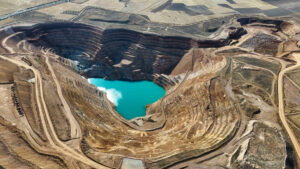Lefroy banks $560,000 R&D refund, calls in the science to advance unique Burns copper-gold discovery

Pic: Alina555/E+ via Getty Images
Since its discovery, the Burns copper-gold porphyry found by Lefroy Exploration last year has been a riddle wrapped in an enigma.
But Lefroy (ASX:LEX) has been employing a world-class approach characterised by industry-leading scientific rigour to unravel the mystery of the astounding find, which despite being found just 70km southeast of the gold Mecca of Kalgoorlie is unlike any other in the Eastern Goldfields.
A $560,000 R&D tax refund from the Federal Government for the 2020-21 tax year announced today is a testament to that commitment to research.
That research has included collaborative work with the Centre for Exploration Targeting at UWA subsequent to initial work completed by the Geological Survey of WA.
Seeing gold, copper, silver and molybdenum hosted in diorite intrusive rocks makes Burns distinct from other deposits in the Eastern Goldfields where well over 100 million ounces of the precious metal have been discovered.
That has drawn the interest and excitement of exploration experts, hopeful to understand Burns and identify more discoveries like it.
Research is aimed at:
- Understanding the geochemical and geological framework to place Burns into a model type.
- Fingerprinting the key geochemical characteristics of Burns to guide further exploration within the system but also the immediate are beneath Lake Randall; and,
- Providing Lefroy and the industry with geological criteria through research publications to explore for and discover similar systems in the EGP.
Unravelling the mystery
The genesis of Burns is yet to be fully understood.
Found on the eastern margin of a large felsic intrusion which is not visible at surface, the spectacular discovery hole in February last year contained 38m at a massive grade of 7.63g/t and 0.56% copper at 134m deep.
Results from the 22-hole RC drilling campaign demonstrated the unique geological characteristics of Burns.
The find is hosted within a complex mineral blend of hematite-magnetite-biotite-chalcopyrite and pyrite-altered diorite porphyry including high magnesium basalt.
Lefroy says the Eastern Porphyry at Burns remains open to the north and south.
The funds from the FY21 tax refund will be used to increase the pace of exploration at Burns and targets nearby on Lake Randall, as well as progress Lefroy’s research with the CET.
That work with the CET is continuing this year and will be ongoing into 2023.
Superdeep diamond drill hole
The main exploration priority at the moment for Lefroy is a 1200m deep diamond hole into the Burns system which will be co-funded by the WA Government through its Exploration Incentive Scheme.
The hole is scheduled to commence in mid-June and is intended to provide a section view of the entire Burns system, including the western basalt, planning to intersect the down plunge extent of the high grade gold and copper zone defined by discovery hole LEFR260 and LEFR320.
Lefroy’s gold project of the same name takes in some 621sqkm of tenure to the east of Kalgoorlie.
The western share is subject to a $25 million farm-in and JV with South African gold miner Gold Fields, owner of the St Ives gold mine. But the exciting Burns find is located in the eastern portion of the tenement package, 100% owned by Lefroy.
A broader aircore drilling campaign has restarted on Lake Randall to test a portfolio of targets over the eastern part of the gold rich salt lake.
This article was developed in collaboration with Lefroy Exploration, a Stockhead advertiser at the time of publishing.
This article does not constitute financial product advice. You should consider obtaining independent advice before making any financial decisions.
Related Topics

UNLOCK INSIGHTS
Discover the untold stories of emerging ASX stocks.
Daily news and expert analysis, it's free to subscribe.
By proceeding, you confirm you understand that we handle personal information in accordance with our Privacy Policy.








